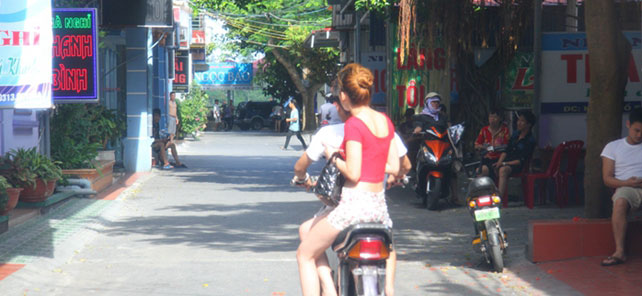
A pimp beckons to a girl to go into an inn. Photos: Zhang Han
Few know about the city of Hai Phong, but it has the largest red light district of Vietnam. The city is located on the four-kilometer Doson Peninsula, which features a mountain ridge. Beaches, hotels, parks and casinos were constructed at the foot of the mountains during the rule of France in the early 20th century, and a red light district came into being in the early 21st century.
The red light district is located in an old industrial zone. Wang Yang (a pseudonym) is a staff member of a Chinese factory in the industrial zone who is responsible for reception and public affairs. He is very familiar with the road leading to the red light district because he needs to take suppliers, customers and Chinese officials to the district on a frequent basis. It costs only less than $14 to avail the services of a prostitute.
People on motorbikes beckon to visitors driving along the seaside road. They are pimps working in the red light district. They will earn about $2 for each customer they’ve brought to the district. In fact, the red light district is a narrow alley which is less than one kilometer long. The alley is lined with three-storey inns on both sides, which seem to have nothing to do with sex workers. However, when a customer walks into any one of them, pimps will bring some Vietnamese girls on their motorbikes for the customer to choose from.
The red light district is deemed as a gray area. Local officials will inform the inn-keepers every time leaders at a higher level are about to make an inspection tour of Hai Phong. During these periods, the alley takes on a look of an ordinary area free of the pimps and prostitutes. Wang said the local government decided to sacrifice three generations of women to boost its economy, and the tax revenue collected from the alley once equals to a large factory.

A pimp takes a girl to an inn on his motorbike.
Wang introduced me to May, a 19-year-old girl studying computer science at a local university. She attends classes during the daytime and cooks for her mother and younger brother after school. In Vietnam, girls need to cook for their parents after turning 15 until they get married. May comes to work in the red light district at around 8 o’ clock every evening when the entire alley takes on a vaguely mysterious look with red light glowing from the windows of the inns.
May learned Chinese in high school, but she still needs help from the translation software installed on her iPhone 3 when talking to Chinese people. She said high school students are required to choose Chinese or English to learn in Hai Phong, but few opt for the latter because Chinese is more useful in the city where almost no white people are seen. May grew up in a single-parent family. Her father died early. Her mother fell ill and her brother started school when she was only 18 years old, so she had to work and provide for her family.
“Why would China and Vietnam go to war? China is so big like you and Vietnam is so small like me,” she said with a smile on her face. Her story created a sense of sadness though she narrated it so happily. We talked for about 20 minutes and I paid her $20. She looked very happy because it was the money she could have earned during a whole night’s work. She held my hands and said, “Thank you! Chinese people are very kind.”
(Translated and edited by Billie Feng)
|
|
||
 |
| Touched | Sympathetic | Bored | Angry | Amused | Sad | Happy | No comment |
Rhythm Media Group is a multi-media company, operating a US-based Chinese daily newspaper, The China Press, and the paper's website - uschinapress.com (which has mobile-app version), as well as a Beijing-based English website Sino-US.com. The group boasts 15 branch offices across the US, and a number of cultural centers focusing on culture-related business in the North America, Chinese mainland, Hong Kong and Taiwan.Launched in September 2012, the Sino-US.com is designed to serve as a bridge between China and the US, and to keep its readership inside or outside China better informed by providing news and insights on China's current affairs, culture, life, business, people and sports.
|
|